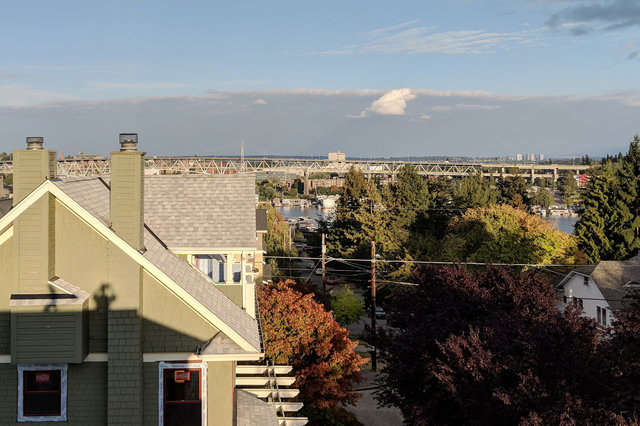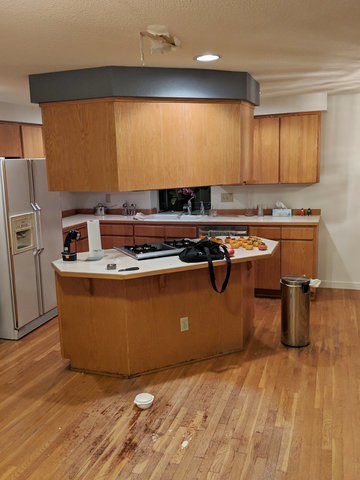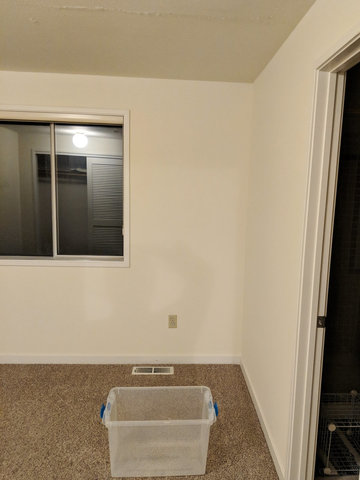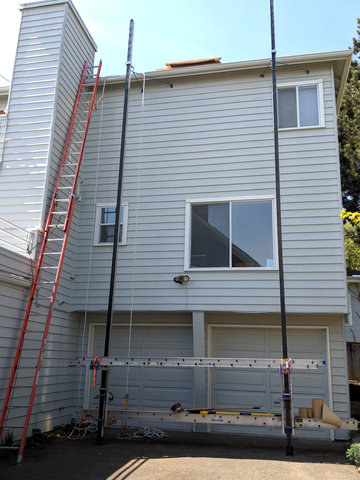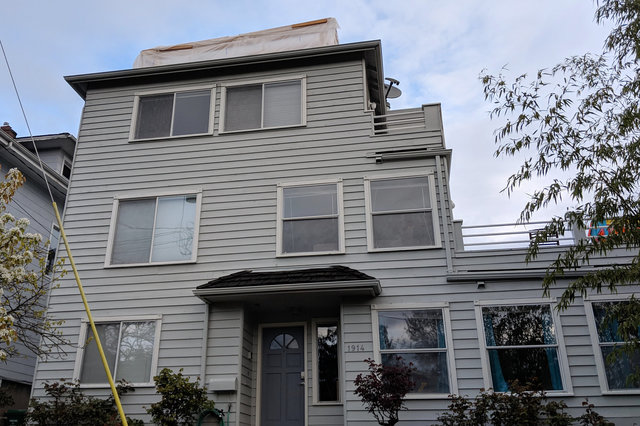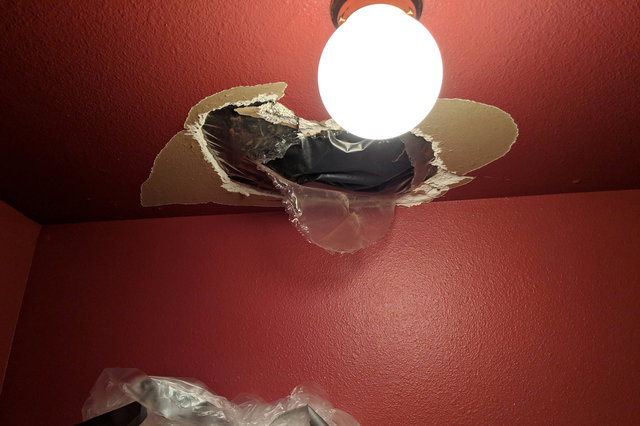Footprints in the Ceiling
Started: 2019-07-05 12:12:12
Submitted: 2019-07-06 00:45:10
Visibility: World-readable
In which the intrepid narrator discovers that the roof on the Wallingford Eighties House leaks, and spends a family minivan to fix it
We bought the Wallingford Eighties House because I liked the rooftop deck. But even before we moved in the roof proved to be a liability.
We were still living in our temporary house in Ballard the week after Thanksgiving. One night I dropped by the Wallingford house to check that a package had been delivered, and to bring it and the mail into the house. I was about to leave when I heard a beeping from the second floor, which I recognized as the anxious alert of a smoke alarm running out of battery. I headed upstairs to the second floor to investigate (and to check what size battery I needed, so I could bring it on a future visit) and I heard a persistent dripping coming from the kitchen.
In the kitchen I found a large puddle on the hard wood floor with water dripping from the drywall in the ceiling. This seemed odd, since I was on the second floor and there was a third floor directly above me. I headed up to the third floor and looked for any source of water in the bathroom above the leak, but I didn't see anything. I went up to the roof and found a large puddle on the roof.
The roof is built like a bathtub, with a large flat surface to walk on, straight parapet walls going up about three feet, metal flashing on top of the parapets, and a 45° sloped roof with regular asphalt shingles going down to a regular gutter hanging off the side of the house. The floor of the bathtub had four small drains, each less than two inches across, on each corner of the roof; plus two additional overflow drains a couple of inches off the floor of the roof. Two of the drains were clear, but two had become clogged with leaves, building up a pool of water in the persistent Seattle winter rain.
I picked up a large plastic bin to put under the drip, and punched a couple of holes in the drywall in the ceiling to give the water a place to go. I unclogged the drains in the roof, then waited for the water to drain. There were a couple of low spots in the roof that weren't caught by the drain, so I found a mop in the garage and used it to push water from the low spot into the drain.
This proved to be a bad idea: the extra water in the drain leaked into the house, opening up a new drip in the third-floor bedroom (which we had allocated as Julian's room), dripping onto the new carpet. I punched more holes in the drywall and put another plastic bin under the drip.
Over the next few days I checked in on the drips, clearing the roof drains as necessary, and verifying that no new water was dripping into the house. We added the roof to the list of things we needed to fix in the house, but the list was long enough that we didn't get to it immediately.
A month or two later, after Julian's bedtime, Julian announced that it was "raining in my room" -- which turned out to be the roof leaking, again. Julian thought this was exciting, and was disappointed when we stopped the leak.
Clearly we had mitigated the immediate incidents, but we were at risk of future incidents unless we dealt with the root cause. (In my day job as an SRE at Google, this would be a postmortem action item.) We mentioned the problem to the design-build company we were working with to remodel our kitchen, and they sent people over to look at the roof and the drains, and kicked off the project to repair the roof.
The first thing they did was set up a pump jack in the driveway to bring people and building materials up to the roof. Then they built a temporary structure on the roof with 2x6 beams just above head level, covered with plastic sheeting, providing enough space to work on the roof with enough plastic sheeting to keep the rain away.
Then they began demolishing the roof itself. They wanted to look under the roof to look for water damage, and to figure out how the drainage system was built (badly, it turned out). So they demolished the entire structure of the roof. To do this they used a reciprocating saw to cut large chunks of roof away from the ceiling joists (where the roof boards were not nailed into the 2x12 ceiling joists), leaving large oval holes in the roof; then they had enough leverage to pry the remaining strips of roof boards away from the joists.
This gave access to the space immediately under the roof, which was filled with insulation and also held the drain pipes that were supposed to drain the roof. Like the drains, the drain pipes were badly underspeced for the roof: all four of the roof drains were connected to a single two-inch PVC pipe that was installed without enough slope to actually carry the water all the way across the roof. They did not find evidence of further water damage under the roof, which was a relief. They did, however, find evidence of several birds' nests and at least one rats' nest; they cleaned out the nests, closed the holes that gave access to the roof, and replaced the damaged insulation.
By this point we were a month into the project, and we were in a delicate point where the roof was entirely absent but they couldn't put the new roof down until they had done all the work they needed to do under the roof. We were relying entirely on the plastic sheeting to waterproof our house; and the plastic sheeting proved to be inadequate during one rain storm. (It's not strictly true that Seattle rains all the time during the winter. There are short breaks between the rain, and sometimes the sun even shines through the clouds. Most of the rain is a persistent drizzle, but sometimes the rain intensifies into an actual measurable storm.)
One evening while the roof was open and exposed we noticed water dripping through the ceiling on the third floor. We went up onto the roof to find that water was dripping through the plastic sheeting at the points at which it was nailed to the 2x6 beams and was then falling through the insulation to drip through the ceiling drywall around light fixtures and vent fans.
And, it turned out, the Nest Protect fire alarm I installed, which woke us up in the middle of the night with an alert that it was failing in some poorly-specified way that seemed to be triggered by water pouring down from the ceiling on top of it. I unplugged the Nest, ran it through its self-diagnostics, and it reported that its sensor board was irreparably damaged. The builders returned in the morning to put a second sheet of plastic on top, one that was only nailed down around the edges so it wouldn't exhibit the same problem. (I also learned, independently, that there are allegedly nails designed to address this problem directly, by sealing themselves when nailing through sheets of plastic.)
Whenever I went up onto the roof, I was careful to walk on the exposed ceiling joists so I wouldn't step through the insulation onto the drywall below. Some of the builders were not so lucky: we ended up with two big footprints in our ceiling where someone had slipped off the joist and ended up ankle-deep in drywall.
At last the builders finished installing the drains and drainage system and were able to install the new roof boards, then install the waterproof roof deck on top of the roof boards.
With the roof replaced, we got the drywall in the ceiling patched (with an almost-imperceptible texture match), and the drywall painted with the best-matched color for the existing paint color, restoring the interior back to normal.
The very end of the project drug on as the builders replaced the gutters around the roof and installed new siding inside the parapet walls and new flashing on top of the parapets and finally took down the pump jack, giving me full access to my driveway once more.
I'm pleased with the way the roof turned out, especially the fact that we can point out, decisively, that we dealt with the leaking roof whenever we sell the house. I just wish we didn't have to pay the price of a family minivan to get there.
